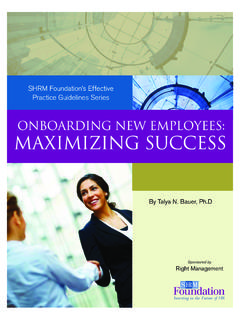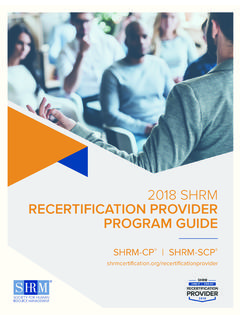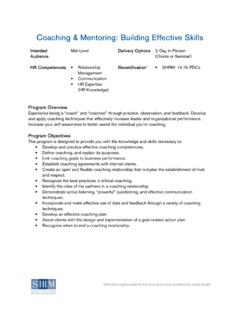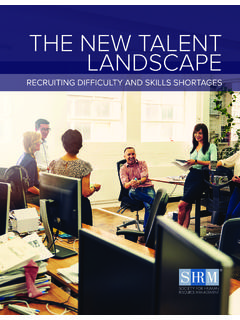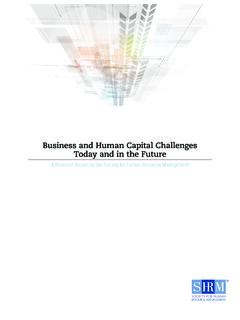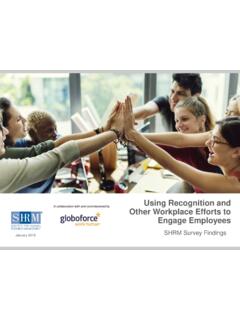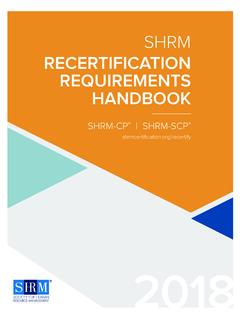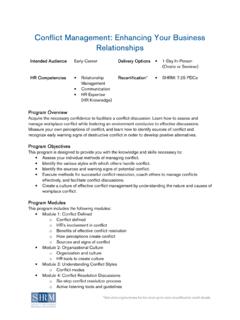Transcription of GENERATIONAL CONFLICT AT WORK: SEPARATING FACT …
1 SHRM FOUNDATION EXECUTIVE BRIEFING. GENERATIONAL CONFLICT AT WORK: SEPARATING FACT FROM FICTION. Defining the Issue sometimes because of the era during which they grew up, C onflict among people of different generations but also because of their different life stages and career is common at work. Baby Boomers, Gen Xers stages. Often GENERATIONAL difference becomes a catch-all and Millennials working closely together sometimes term for a variety of differences. For your organization to have difficulty getting along. Their conflicts can lower be successful, you need to address all these issues effectively engagement and productivity. Tensions are often attributed while counteracting GENERATIONAL stereotypes that distract to GENERATIONAL differences, but the latest research says this is from the real sources of the CONFLICT . not true. This briefing provides practical recommendations Today, more people are choosing to work later in to help you separate fact from fiction and enhance the life, and as a result, employees with an age difference of engagement and productivity of everyone in your workplace.
2 40 years or more may work closely together. We all notice some differences between younger and older co-workers Generations by the Numbers immediately: the way they dress, the music they like, how Most of the workers in the United States belong to three they use technology, and how they communicate. People generations: Baby Boomers (born between 1946 and 1963), decades apart in age often find that they have different Gen Xers (born between 1964 and 1979) and Millennials attitudes about the workplace and appropriate behavior (born after 1980). The types of jobs in which members Table 1. Generations by the Numbers Generation Baby Boomers Gen X Millennials Birth years 1946-1963 1964-1979 1980-2000. Age in 2015 52 to 69 years old 36 to 51 years old 15 to 35 years old Percentage of professional and 30% 35% 32%. managerial workforce Percentage of generation who are 27% 26% 16%. managers or executives Note: The authors calculated the above based on data for the United States civilian labor force, restricted to professional and managerial occupations, as reported in the May 2015 Current Population Survey.
3 1. of each generation congregate are not very different, but to consider in designing career opportunities is what an managerial and executive positions are more common individual wants to accomplish, not what generation he or among older workers. Only 16 percent of Millennials she comes from. currently hold managerial positions, although that is a substantial number, given their age. Everyone has something to offer your organization, regardless of age. Stereotypes based on age are common in most Moving Beyond Generations: organizations. For example, managers may argue that the What Really Matters youngest employees are too young to have much to offer, What employees want usually is a function of their life stage and so they should be quiet, listen and learn rather than put career stage, not their generation. forward ideas and suggestions. Others may suggest that the The era during which we grew up helps shape our view oldest employees are irrelevant and out-of-date. Clearly, both of work, our relationships and our place in the world, but assumptions are wrong.
4 Organizations benefit the most when what we need and want depends on our circumstances at a they are able to leverage diversity of experience and use it to particular point in time. Our life stage and career stage affect improve products and processes. what we want, expect and need to be happy and productive at work. CONFLICT is typically about power and control, not about generation. For example, people who don't have children are in Conflicts that appear to be GENERATIONAL are often about a different life stage than those who have children. The who has the power to call the shots and who must obey. demands on anyone are different once children arrive, In today's workplace, conflicts often arise over demands whether the person is a 24-year-old Millennial or a 44-year- for work-life flexibility. Rules and attitudes are evolving as old-Gen Xer. Employees at the same life stage usually have a result of improvements in technology. Some employees more in common than those who are at different life stages.
5 Believe most work should be done in the office, but others Career stage also affects what people want and need disagree. As the ability to work anywhere and anytime at work. A larger percentage of Millennials than Xers or expands to include more positions, the balance of power Boomers may seek promotions because they are in earlier among employees and questions about how each employee's career stages. But you should not assume that all Millennials time is managed can change. Because managers are more want to be promoted, even if they are working in a job likely to be members of older generations and frontline designed to train people for higher levels. employees are more likely to be Millennials, conflicts about how time is managed are often seen as GENERATIONAL . But the Organizations should focus on job level and type of occupation, true source of the CONFLICT is power and need for control, not rather than generation, when thinking about development options. GENERATIONAL differences.
6 The development an employee needs depends more on career stage than on age or generation. The primary factor Real GENERATIONAL differences are often less important than they appear. Figure 1 There are some real differences between generations Major Life Stages that are not due to life or career stage. For example, Millennials are more likely to use texting, instant messaging and social media to communicate with their peers; Gen Xers are more likely to use phones and e-mail. These differences in communication can lead to conflicts, but preferences do shift over time for all generations. For example, Facebook's user base now includes a majority of the entire population, and older users are the fastest-growing group. Initially, e-mail was a tool adopted by Gen Xers, but today it is used by all generations at work. 2. Figure 2. Major Career Stages What matters for your organization is whether executives have similar developmental needs, GENERATIONAL differences have a demonstrable impact in the regardless of their generation.
7 Organizations should workplace. In the case of technology use, our research shows focus an employee's development strategy more on that all generations prefer to have critical conversations his or her role in the organization and downplay the about themselves in person, not electronically. When it issue of generation. comes to talking about performance, compensation and 3. Take advantage of early adopters of technology. Younger career planning, everyone wants face-to-face conversations, people are more likely to embrace new technology, even Millennials. often adopting the latest trends that eliminate repetitive or boring tasks. They can help your Strategies for Success organization figure out how to make good use Several proven strategies will help your organization of technology and help older workers learn new effectively address conflicts among generations: systems when they are in place. 1. Think more about life stage and individual career desires 4. Leverage experience. Employees learn a lot over the than about generation.
8 Take life and career stage into course of their careers, including knowledge that account when putting in place policies that address comes only from experience and cannot be taught workplace flexibility and benefits plans in particular. in school. Never forget that older workers have What works for an employee at one life stage won't knowledge that can be used to help the organization be as effective for another worker at a different as a whole and to help employees with less stage. Offer flexibility tailored to employees' needs, experience develop more quickly and efficiently. and you'll be more likely to keep the best and the 5. Understand the role of power and control in creating brightest. CONFLICT . Employees who are a level higher than 2. Recognize that a worker's role in the organization is a others in the same generation may criticize better predictor of developmental needs than generation. the immaturity of young employees, without Employees with similar roles whether they recognizing that all that separates them from the are hourly workers, technical staff or senior younger workers is one promotion.
9 Remember that 3. the desire for and use of power is the central issue in differences in life stage, career stage and job level not most conflicts, not generation. GENERATIONAL differences. Even if your employees want to frame issues in terms of GENERATIONAL differences, your Conclusion efforts will be more productive if you focus on what drives Many conflicts within organizations are a result of motivation and behavior across generations. About the Authors Alec Levenson is senior research scientist at the Center for Effective Organizations, Marshall School of Business, university of Southern California. He specializes in action research and consulting on strategic talent management, human capital analytics, and organization design and effectiveness. His work focuses on scientifically accurate, practical and actionable knowledge that companies can use to improve performance. His work has been featured in the New York Times, Wall Street Journal, The Economist, CNN, BusinessWeek and other media.
10 He is the author of strategic Analytics: Advancing Strategy Execution and Organizational Effectiveness and Employee Surveys That Work. Jennifer J. Deal is a senior research scientist at the Center for Creative Leadership in San Diego, Calif., an affiliated research scientist at the Center for Effective Organizations at the university of Southern California and a contributor to the Wall Street Journal Experts panel on leadership. Her work focuses on global leadership and GENERATIONAL differences, and has been featured in the Harvard Business Review, New York Times, Wall Street Journal, CNN, Time Magazine, Forbes and other media. She is the author of Retiring the Generation Gap: How Employees Young and Old Can Find Common Ground and co- author of Success for the New Global Manager. This briefing was funded by a grant from the The content for this Executive Briefing is drawn from Jennifer J. Deal and Alec Levenson's new book What Millennials Want From Work (McGraw-Hill, January 2016).

